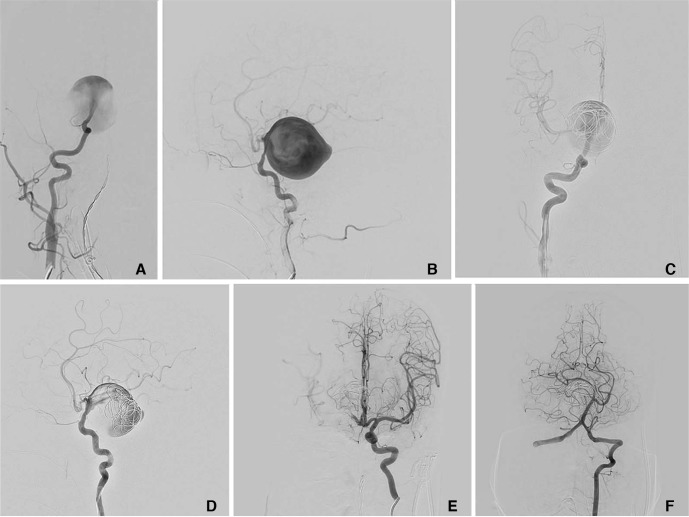Neurointervention.
2018 Mar;13(1):58-61. 10.5469/neuroint.2018.13.1.58.
Kinking of Flow Diverter in a Giant Wide-Necked Supraclinoid Internal Carotid Artery Aneurysm
- Affiliations
-
- 1Department of Neuroimaging and Interventional Radiology, NIMHANS, Bangalore - 29, India. gupta209@gmail.com
- KMID: 2424051
- DOI: http://doi.org/10.5469/neuroint.2018.13.1.58
Abstract
- We report here a rare complication in the form of kinking of flow diverter in a case of giant wide-necked supraclinoid internal carotid artery (ICA) aneurysm 48 hours after the procedure. This 28-year female presented with giant wide-necked right supraclinoid ICA aneurysm which was managed by flow diversion. On 2nd post-op day, patient developed weakness of left side with altered sensorium - angiography and CT showed kinking of flow diverter at the neck of the aneurysm with poor distal flow. Eventually, the patient developed right middle cerebral artery infarct for which decompressive hemicraniectomy was done. The likely cause of development of kink is because the aneurysm was wide-necked, the hemodynamic forces have resulted in inward buckling of the flow diverter at the aneurysm neck. This case shows that kinking of flow diverter can still happen 48 hours post-procedure.
Keyword
MeSH Terms
Figure
Reference
-
1. Fiorella D, Woo HH, Albuquerque FC, Nelson PK. Definitive reconstruction of circumferential, fusiform intracranial aneurysms with the pipeline embolization device. Neurosurgery. 2008; 62:1115–1120.
Article2. Krishna C, Sonig A, Natarajan SK, Siddiqui AH. The expanding realm of endovascular neurosurgery: flow diversion for cerebral aneurysm management. Methodist Debakey Cardiovasc J. 2014; 10:214–219. PMID: 25624975.3. Becske T, Kallmes DF, Saatci I, McDougll CG, Szikorg I, Lanzino G, et al. Pipeline for uncoilable or failed aneurysms: results from a multicenter clinical trial. Radiology. 2013; 267:858–868. PMID: 23418004.
Article4. Lylyk P, Miranda C, Ceratto R, Ferrario A, Scrivano E, Luna HR, et al. Curative endovascular reconstruction of cerebral aneurysms with the pipeline embolization device: the Buenos Aires experience. Neurosurgery. 2009; 64:632–642. PMID: 19349825.5. Nelson PK, Lylyk P, Szikora I, Wetzel SG, Wanke I, Fiorella D. The pipeline embolization device for the intracranial treatment of aneurysms trial. AJNR Am J Neuroradiol. 2011; 32:34–40. PMID: 21148256.
Article6. Kadirvel R, Ding YH, Dai D, Rezek I, Lewis DA, Kallmes DF. Cellular mechanisms of aneurysm occlusion after treatment with a flow diverter. Radiology. 2014; 270:394–399. PMID: 24086073.
Article
- Full Text Links
- Actions
-
Cited
- CITED
-
- Close
- Share
- Similar articles
-
- Symptomatic Post Endarterectomy Common Carotid Artery Pseudoaneurysm Treated with Combination of Flow Diverter Implantation and Carotid Stenting
- A Case of Traumatic Giant Aneurysm
- Salvage flow diverter stent across the posterior communicating artery for persistent retrograde filling of a giant internal carotid artery aneurysm after parent vessel occlusion
- A Case of Giant Paraclinoid Aneurysm
- Supraclinoid Internal Carotid Artery Fenestration Harboring an Unruptured Aneurysm and Another Remote Ruptured Aneurysm: Case Report and Review of the Literature



